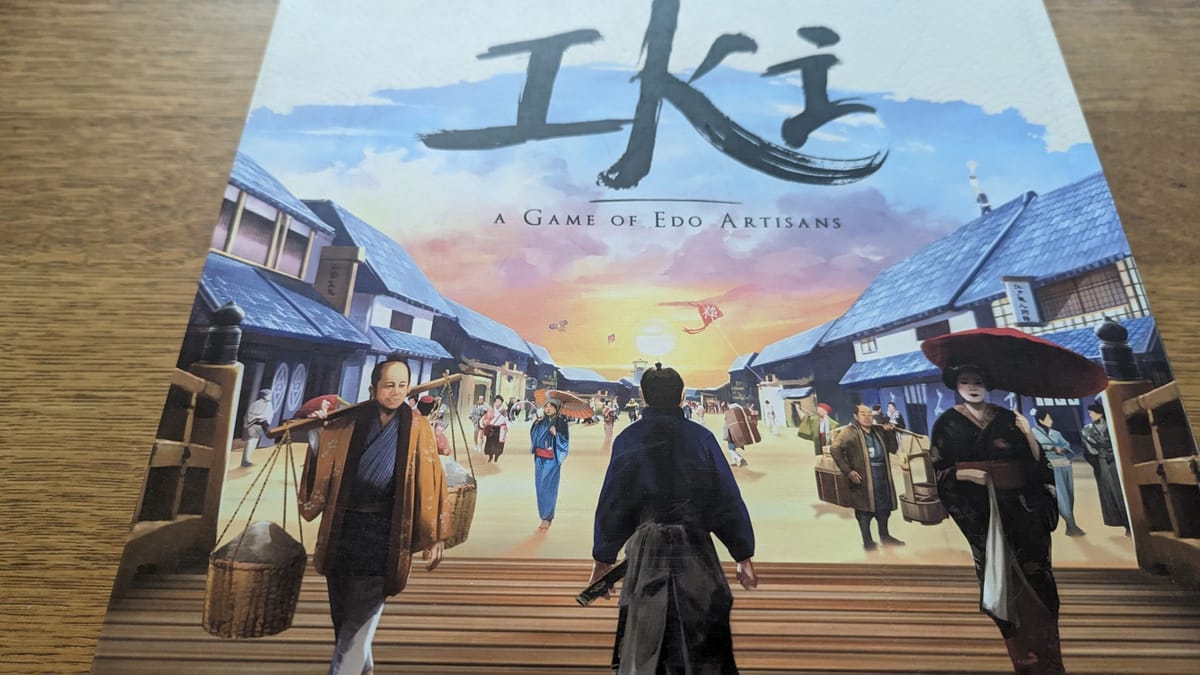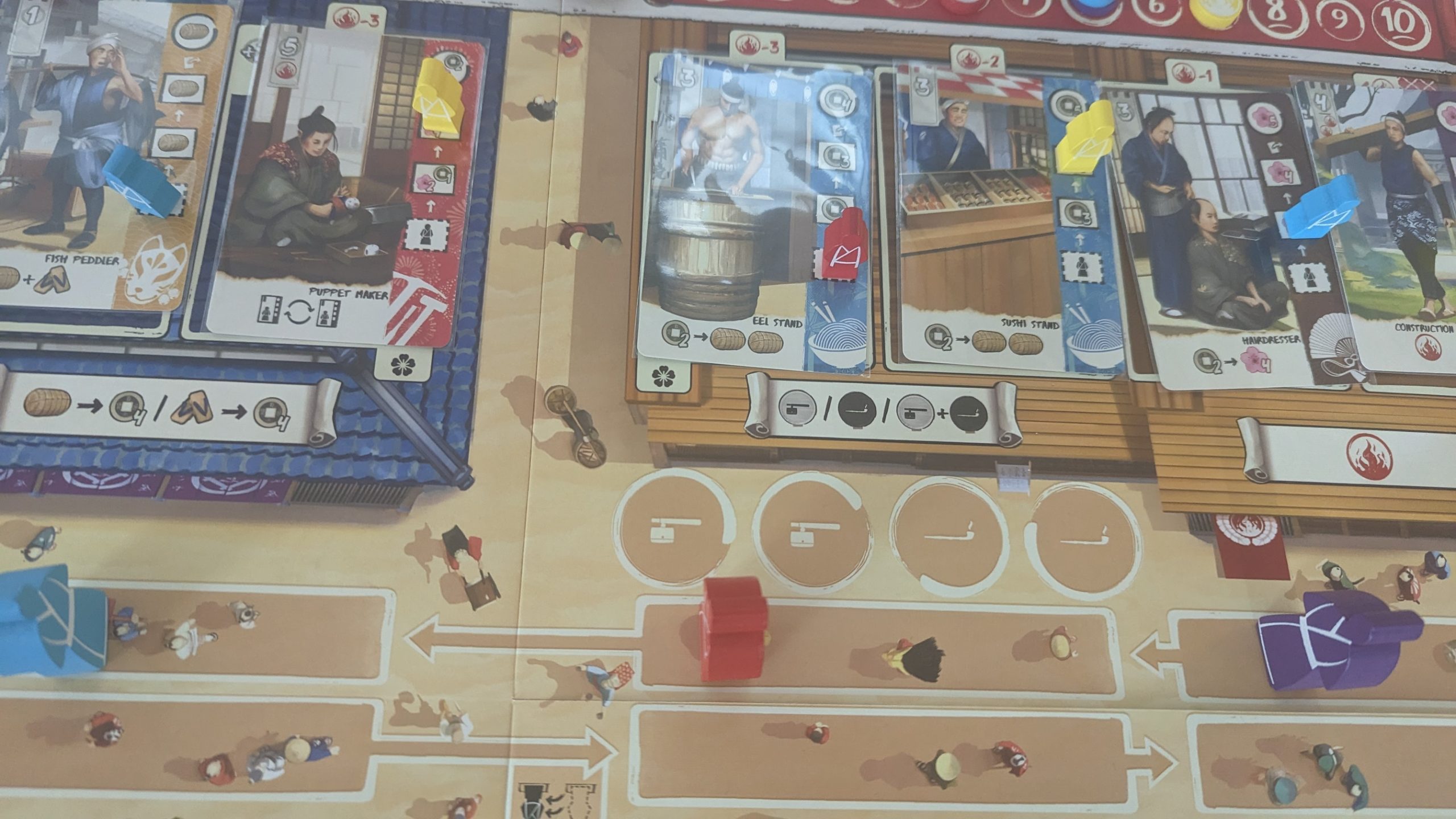
Recently, I started watching The Wire for the first time. I know, I should have watched it forever ago, but it was just one of those things that everyone kept telling me was great but I never got around to. Honestly, I think that because it’s more about the ecosystem of its fictionalised Baltimore than any specific character it defied the accurate, brief descriptions I wanted back when it was popular. Iki is in a similarity boat- simply, it’s about Edo nobles funding various street vendors and then shopping while strolling up and down the street, but that simplification fails to address the ecosystem of mechanics and interaction that make Iki a game I honestly believe every hobby enthusiast should play at least once.
In general, I try to avoid doing a full teach in my reviews. There are multiple YouTubers who have formed their channels around teaching games better than I could ever hope to, so all I’d do by attempting to do so is waste everyone’s time. Iki is going to have to be an exception, as every mechanic is built upon another to the point that there really isn’t a way for me to properly communicate its beauty without explaining just about everything. Every round starts with the addition of new artisans to the market area, followed by a strange combination of worker placement and programming where players in reverse firefighting order put their hat boys on their desired place on the movement track, which will determine how far their big boy moves on the street during the shopping phase and the order for the upcoming hiring phase, with slower players having first choice. When the hiring phase starts, players have the option to pay an artisan’s cost, slot them into a stall and put one of their tiny boys on their starting level, or just take four coins. If you took the wild 1-4 space (usually because someone took the movement number you needed and didn’t have the resources to correct with another one), you skip hiring and just get one coin. After everyone’s done hiring, you go to movement, where all the excitement of walking around and shopping for stuff you can barely afford happens. In ascending distance order, players walk their big dudes counter clockwise the distance they took with their hat guys, moving an extra space for every sandal token they spend. They then can perform the action printed on the shop they land on and/or an artisan in a connected stall in whichever order they choose- for example, a player could hit up an artisan to get the money to buy something from the connected shop, or vice versa. When a player uses an artisan that they don’t own, it’ll level up (more on that later), meaning that when you’re hiring artisans you’re almost always better off adding someone that helps another player’s strategy rather than your own. Once everyone’s moved their big boy, it’s time to do some maintenance and move on to the next round.

Every few rounds, the seasons will change, most importantly meaning payday happens. During payday, everyone takes income and feeds their active artisans, but artisans you had previously fully levelled up would have retired, meaning you get their best income reward while not having to feed them. Players with artisans still on the board will get to do harmony scoring, a nice smattering of points for like colored artisans in the same area.

But that’s not all! A handful of times a game, a fire will break out in a random area at the end of a round. Fires are another mechanic that are simple enough to teach but open up a depth of strategy implications. They’ll break out in a stall closest to the board edge and spread inwards until someone has firefighting strength to match the fire and stop it. The later in the game, the stronger the fire, and the more important it is to hide your artisans inside of players with high enough strength to stop the fire.There’s more to a full teach, but I’m just hitting the highlights that have the biggest gameplay implications. I know it seems like a lot, but I don’t like games this much (and they don’t get shortlisted for the Kennerspiel) unless they’re easy to get the hang of while still having deep decision space. The major selling point, and why I love Iki so much, is how tight everything is while not crossing the line into overly punishing. There’s no way you can do everything, so the path to victory is choosing where you’re getting your points from and where you’re only dipping your toe in for opportunistic points efficiency, which will change between games and groups, as every game will have a different assortment of artisans and buildings, and every player will have their preferred playstyle.
Iki
Excellent
Iki is a beautiful production of interwoven mechanics, but be warned that the way everything overlaps makes the teach a bit rougher than it usually is for a game of this weight.
Pros
- High player interaction that is overwhelmingly positive
- Gorgeous production
- The optimal strategy will change from game to game
Cons
- Particularly rough teach for a middleweight game
- Some people will be put off by the random fire spawns, which can be devastating if you're unlucky and underprepared
